Forests and Rangelands Success Story
Partnering to Create Firewise Communities
Pocatello, Idaho
National Fire Plan - Community Assistance
2008
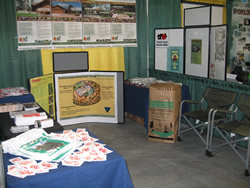
GIFF booth at Spring Fair 2008, promoting spring cleaning for a "lean, clean and green" WUI of Bannock County.
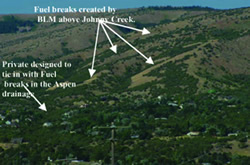
Several hazardous fuels reduction projects laid out and administered by Pocatello Field Office fire use specialist in partnership with Three Rivers RC&D.
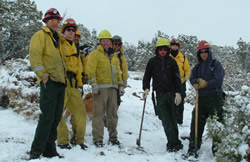
BLM fire and fuels crews worked year-round alongside local fire departments to remove hazardous fuels on private lands.
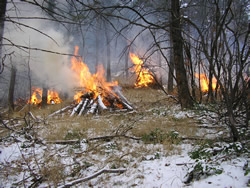
Some of the hazardous fuels were removed by thinning, piling, and burning the debris..
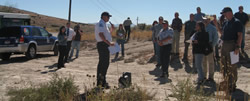
Eric King, Chubbuck Fire Department Chief, speaks to the group on the fieldtrip that was conducted by Three Rivers RC&D in September of 2008.
The city of Pocatello, Idaho, is nestled in a scenic valley at the foothills of the Rocky Mountains, surrounded by sloping hills and picturesque high-desert vegetation. Pocatello is a prime example of a peaceful, small metropolitan area; urban living mixed with a rural setting, attractive neighborhoods peppered amongst wildlife-infused juniper forests. Because of its charming setting, many homeowners have moved to the city’s outlying neighborhoods even though the area is frequently visited by wildfire, which has created wildland urban interface (WUI) conditions in many of Pocatello’s neighborhoods.
The Three Rivers Resource Conservation and Development (RC&D) Council and the Gateway Interagency Fire Front (GIFF) have partnered to reduce the wildfire risk in WUI areas on public and private lands in Bannock County, Idaho, where Pocatello is located. The Three Rivers RC&D Council is a nonprofit organization enhancing community development in southeast Idaho through conservation of natural resources; it serves Bannock, Bingham and Power Counties and the Fort Hall Indian Reservation. GIFF is a consortium of Bannock County Emergency Services, local fire departments, Forest Service, and the Bureau of Land Management (BLM).
The Three Rivers RC&D Council has been awarded several grants from the BLM, Federal Emergency Management Agency (FEMA), Pocatello Fire Department, and Idaho Department of Lands (IDL) in cooperation with the US Forest Service to implement hazardous fuels reduction projects on private lands. Idaho Falls District (IFD) BLM has had a large role in steering this partnership that was formed in 2000 and fostered over the last eight years, proving to further the working relationships long into the future. This relationship has served to help educate homeowners in southeast Idaho about the risks of wildfire and about how to create defensible space around their homes. Defensible space creates a barrier between a home and its surrounding vegetation, which greatly increases any home’s chance of surviving a wildfire.
The IFD alone has provided a great deal of funding to Three Rivers RC&D Council through cooperative agreements for projects that have culminated in the completed acres seen on the ground today. From 2003 to date, the IFD funded Three Rivers RC&D Council a total of $581,000 in a "Communities at Risk" grant. The results are directly related to achievements throughout the process, from initiating an education and information campaign, to project lay out, to the actual burning and removal of hazardous fuels on private land.
The IFD largely funds and supports the implementation of a comprehensive education program called Wildland Fire Education and Prevention (WFEP). The Three Rivers RC&D Council established WFEP objectives to educate homeowners and the general public with offerings such as Firewise techniques (creating defensible space and improving the home itself to increase its survivability during a wildfire) and free home evaluations for those living in the WUI. They also unite with IFD on several recurring opportunities for education:
- The WUI wildfire simulation with GIFF involves both city and wildland firefighters training for possible wildland urban interface fires.
- Events such as the Johnny Creek Block Parties gather community members together on a certain day to clean up flammable vegetation around their homes.
- Community exhibits such as the Spring Fair.
In many cases, homeowners in wildland urban interface areas are unaware of the risks associated with wildfire. By educating homeowners, BLM, the RC&D, and WFEP created a collective consciousness about wildfire and motivated homeowners to take action.
The BLM Pocatello Field Office fire use specialist provided Three Rivers RC&D with technical assistance and contract administration on a majority of the projects. The IFD fire and fuels crews burned and removed the hazardous fuels alongside local fire departments. Additionally, the IFD funded the purchase of supplementary tools needed at various steps of the process, such as REDZONE projects for numerous fire departments within Bannock County and a chipper for fuels removal. REDZONE is a software program designed to bring professional quality survey, Geographic Information Systems (GIS), and mapping capabilities directly into the hands of firefighters and/or homeowners. Firefighters and homeowners use the software to record data about WUI areas and then utilize the information to diminish wildfire risk around homes and entire neighborhoods.
On September 24, 2008, the Three Rivers RC&D Council hosted a tour to highlight wildland urban interface collaboration throughout Bannock County. The RC&D Council highlighted seven different locations throughout the county where wildland urban interface areas had been treated using varied treatment methods and tactics, including hazardous fuels reduction and the creation of defensible space around homes and neighborhoods.
Several cooperating agencies and partners came together for the tour in Bannock County foothills. Participants included representatives from the Three Rivers RC&D administration and board, Pocatello and Chubbuck Fire Departments, Senator Crapo’s Office, Bingham County Commissioners Office, BLM Idaho State Office, Caribou-Targhee National Forest, and Pocatello’s NBC affiliate, KPVI Channel 6.
Contact: Sonja Shadow, Fire Prevention & Information Specialist, Idaho Falls District Bureau of Land Management, (208) 524-7613